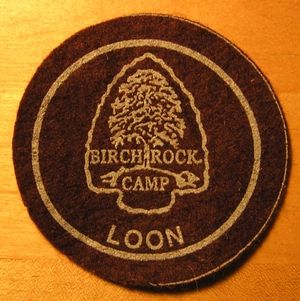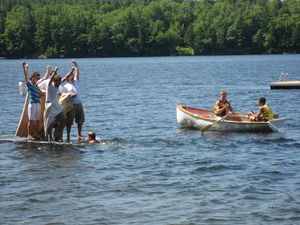Long distance swims
Long distance swims are special challenges a camper may do. There are four different swims of increasing distance. First there is the duck, then the loon, then the seal, and then the whale. These swims are basically the badges for swimming. When the waterfront director thinks a camper has the ability to do a long distance swim, he will tell the camper and the camper will choose if he wants to do it. The duck and loon are done during the campers swimming period while the seal and whale are usually done in the morning because they take a considerably longer time. Always during a swim the camper is spotted by a row boat for safety.
Contents
The Duck
A duck is swimming the shortest distance across the lake, from the swimming docks to the other side.
The Loon
A loon is simply two ducks. The camper swims to the other side of the lake and back, a distance of around 0.9 miles. A loon takes around an hour to swim usually. After swimming his loon, a camper will receive a Birch Rock cheer from the camp at the next meal. At the end of that camper's summer he will also get the loon badge.
The Seal
The seal is a step up from the duck and loon. It is more than two times as long as the loon, being more or less two miles long. It is also almost never done in lower camp, and sometimes even senior campers do not get to do it. A camper needs to show real swimming skill to be allowed to swim the seal. Seals are often swum by a camper the year before his senior camper year, this usually means that he will swim his whale next summer.
A camper is sometimes woken up before the morning bell to swim his seal. At flag pole the whole camp may be able to see the row boat out in the middle of the lake with a tiny head bobbing behind it. Most of the time he starts his seal on the aptly named seal rock, a submerged rock at one end of the lake. The camper and two counselors row out to the rock to start. Seal rock is about ten feet tall and goes up to less than a foot below the surface. The camper then gets out of the boat and stands on the rock from which he will dive. At this point he may choose to take off his swim suit for more speed. The counselors in the boat count down and the camper dives into the water. Seals take anywhere from one to two hours. The actually distance of the seal may vary depending on how straight the boat goes for the camper to follow. After the camper gets to Waziata they all row back to camp. At the next meal the camper will get a standing Birch Rock cheer and at the end of the summer, a badge for him to keep. The campers name will also be put up on the plaques for the year under 'seals' along with his time.
There is a lot of variation when it comes to how a camper swims his seal. He may swim from seal rock to Waziata (the camp at the other end of the lake) or in the opposite direction. He may swim early in the morning or in the afternoon. It could be just him swimming or a whole group.
The Whale
The whale is the longest of all long distance swims. It consists of swimming all the way around the lake, and unclear distance between four and six miles. Only senior campers and sometimes older counselors ever swim their whale.
The Swim
A camper must be very prepared to swim his whale. He will know if he will swim his whale if he has swum his seal the previous year. Otherwise he cannot do his whale, but there are some exceptions. Whales almost always are swum near the end of the summer so the campers swimming them will have the maximum amount of time to get in shape. Some campers will do extra swimming or "whale training" to be even more prepared. The camper never knows exactly when he will be woken up to do his whale. It comes as a surprise when early in the morning counsellors come into his cabin to wake him up. He will go down to the water with and cover himself with Crisco to ward off the cold of being in the water for hours and to make himself more swift. He will then jump in and start to swim either clockwise or counter-clockwise depending on his preference. When a whale is close to being finished, a bell will ring and the whole camp will go down to the water to cheer the swimmer on.
The achievement
At the next meal the whale will receive two standing Birch Rock cheers. He will also be accepted into the whale club. The club consists of every person who has ever swam his or her whale (the only her being Gene Hard). All of the whale club members present will hug the new whale and he will forever be in the whale club. At the end of the summer the new whales will all receive a whale badge. Their names will also be put up on the plaques under "whales".
Noteworthy whales
There have been a few whales through the years that deserve special mention.
Jean Hard
The first whale ever and the only woman to ever swim her whale.
Will Weeks
Possibly the hardest whale ever swum. The wind was against him almost the entire way and he swam through white caps. His legs cramped for the last quarter of the way, making him rely entirely on his arms. He did manage to finish with the longest whale ever done, a record that would be beaten by Chris McElrone. He was in the water for more than four hours. On the whale plaques for that year there are waves carved next to his name to make note of his harsh swimming conditions.
Andrew Bowden
The fastest whale ever, taking him only two hours and one minute.
Pat Bowden
The third fastest whale ever, at two hours and eight minutes. He missed his brother's record by only seven minutes.
Chris McElrone
The longest whale ever, purposefully beating Will Week's time.
Chris Cogswell
The second fastest whale ever, at two hours and three minutes.


